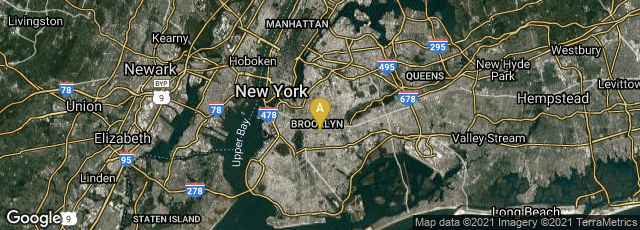

A: Brooklyn, New York, United States
In 1904 David N[unes] Carvalho, a questioned documents examiner of ink, handwriting and paper in New York City, of Sephardic Jewish descent, issued what appears to be the first extensive history of ink, with the following verbose explanatory title:
Forty Centuries of Ink, or A Chronological Narrative Concerning Ink and its Backgrounds, Intoducing Incidental Observations and Deductions, Parallels of Time and Color Phenomena, Bibliography, Chemistry, Poetical Effusions, Citations, Anecdotes and Curiosa Together with Some Evidence Respecting the Evanescent Character of Most Inks of To-Day and an Epitome of Chemico-Legal Ink.
Carvaho's book was published by the Banks Law Publishing Company of New York, and appeared in the standard dark yellowish brown buckram binding with red and black labels on the spine. Written before the widespread use of typewriters, when virtually all legal documents were handwritten, the study of ink was applied more frequently in legal cases than it is today, when so many legal documents are wordprocessed. Yet some of the issues still apply to handwritten legal documents, or any documents on paper.
This book came to my attention when in 2014 I ordered a copy of the first edition that contained a handwritten letter from Carvalho to William G. Pengelly, whose signature is on the front free endpaper of my copy. Pengelly also made neat notes in pencil, indexing to pages of interest on the back rear pastedown endpaper.
Carvalho's letter reads as follows:
New York, March 2, 1905.
Wm. G. Pengelly Esq,
My dear Sir:- Per your request I append my autograph to these lines for insertion in "Forty Centuries of Ink, They are written with a Tanno-gallate of Iron ink without added color. May success crown your efforts in the establishment of an official ink for the state of Ohio.
Cordially,
David N. Carvalho.
In looking up the word "Tanno-gallate" online I was surprised to find a Carvhalho's personal explanation of the term in a transcript of his very interesting testamony published in Documents of the State of New York, Vol. 16, Proceedings of the Senate in the Matter of Investigation Demanded by Senator Jotham P. Allds (1910), pp. 1923-1941. Carvalho's definition appears on p. 1924:
"Q. Would you say in a few words what you mean by tanno-gallate of iron ink? A. Gallate acid is found ready made in the bark of some oak tree in connection with tanno. But it is best found in a little excrescence on certain oak trees due to a puncture by a female wasp, making what is called, after the bud dies, what is called gall nuts. Now in that gall nut is found gallate anno acid. Gallo tanic acid when brought into contact with iron, with sulphate of iron, forms the compound which was used in our father's time known as ink, when it was suspended in water by the use of a little gum. The inks, however, of to-day, which are known as chemical writing fluids, are not what we call oxidized inks, as they were in olden times, before bottling. But there is put into the ink as made to-day, by a cold process and not by a boiling process, what we designate as a provisional color, mostly blue, so that when you write first, the ink writes blue, and after a period of time the tanno-gallate of iron, which has an affinity for the oxygen of the atmosphere, begins to blacken and overcomes the blue coloring matter. That blue coloring matter, however, which is aniline—and aniline is a generic term for certain by-products of coal tar, is fugitive in character—that is to say, does not loosen, and after a period of time that blue which is in the ink gradually disappears, leaving the oxidized iron ink present. That is what we mean by a tanno-galle of iron ink, where something taken from nut galls is brought into union with sulphate of iron."
An issue in the legal case in which Carvalho testified was the dating of writing in documents that could be calculated by the level of fading of the blue provisional color. Thus, for permanence of records, Carvalho recommended using "Tanno-gallate of Iron ink" wihout added color, and one of his pet projects was to lobby governments of the various states to standardize ink for permanence. William Pengelly, to whom Carvalho addressed his letter, was a questioned documents examiner in Ohio. From Carvalho's letter we may assume that Pengelly was also attempting to get the government of Ohio to standardize ink used in state documents at the time.
After Carvalho's death his daughter Clare published Crime in Ink, co-authored with Boyden Sparkes. (1929). This work recounted some of Carvalho's most notable cases, including his participation exonerating Dreyfus in the Dreyfus Affair. Most of Carvalho's cases described in involved unfaithful spouses and disputed wills. Claire noted that 'long before his career had passed its zenith my father estimated that he had affected the courts’ decision as to the ownership and possession of property aggregating over $200,000,000.' This amount, adjusted for more than 100 years of inflation, amounted to over $4.5 billion in 2014.
Carvalho was also a rare book collector; Dodd, Mead offered his collection of 15th and 16th century books for sale for $10,000 in 1911 in A Catalogue of the David N. Carvalho Collection of Incunabula Consisting of a Sequence of Dated Books, 1470-1499, together with a Number of Sixteenth Century Books The unusually thorough bibliographical catalogue contained a preface by Carvalho.